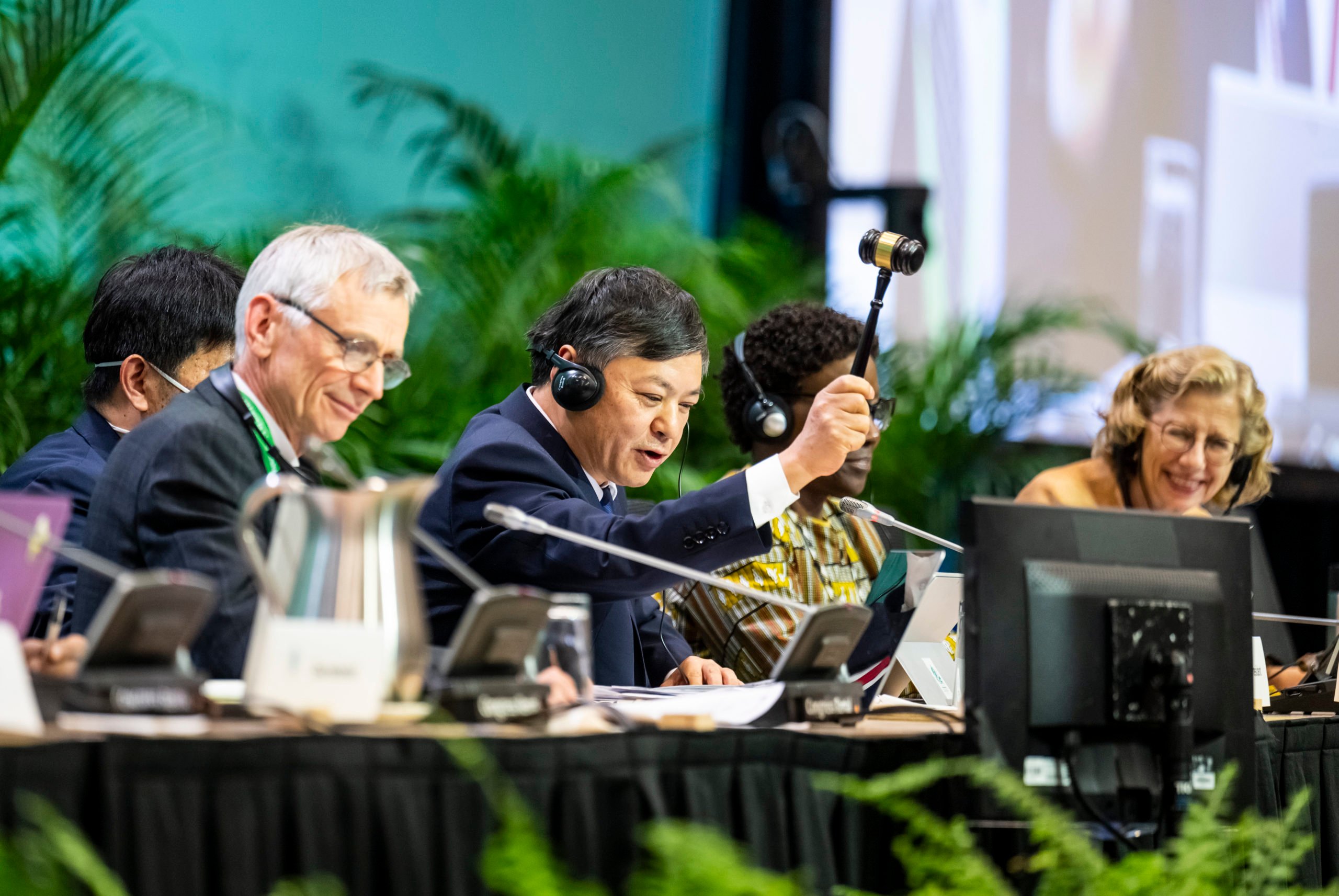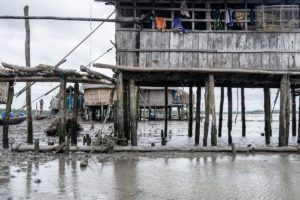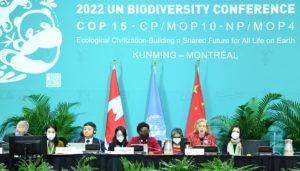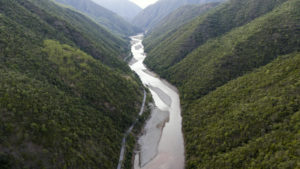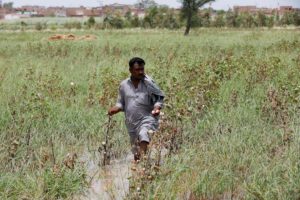Early on 19 December in Montreal, negotiations at the 15th Conference of the Parties (COP15) to the UN Convention on Biological Diversity (CBD) came to a contested close.
After intense closed-door negotiations, the final plenary, which was originally set for 9pm, started at 3am. The text of the Kunming-Montreal Global Biodiversity Framework (GBF) was presented for formal adoption. For two weeks, parties had painstakingly negotiated this agreement that will guide biodiversity conservation until 2030. The Democratic Republic of the Congo objected, on the grounds that the text failed to create a new dedicated fund to fulfil the agreement. But due to mis-phrasing of diplomatic language and translation delays, the objection was not formally recognised. Moments later, the gavel was struck, the GBF was adopted and history was made.
High ambition but lacking finance
The outcome of COP15 was in an important way the exact opposite of November’s climate COP27 in Sharm el-Sheikh. The climate COP was lambasted for failing to strengthen collective pathways for keeping global warming within the 1.5C limit, yet it managed to deliver a momentous loss and damage fund for vulnerable countries suffering from climate disasters. Biodiversity COP15, on the other hand, delivered a “historic deal” containing the ambitious global target of protecting 30% of Earth’s surface area by 2030, but failed to establish a dedicated finance mechanism for meeting this target.
In both conferences, the longstanding rift between developed and developing countries manifested more starkly than ever before. Wealthy countries championed ambitious targets, while developing countries insisted on delivering funds for achieving them and compensation for losses. The diplomatic impasse at both the climate and biodiversity conferences was palpable. Yet, at the climate COP, developing countries seemed to have tipped the scales in their favour.
The climate loss and damage fund, considered the “lone success” of COP27, was pushed through on the last day of the conference. After years of refusal, culminating in two weeks of stalling negotiations, the EU, US, UK, and Australia suddenly changed position, agreeing at the 11th hour to establish the fund. “If that is the only way we are going to get an agreement here at Sharm el-Sheikh,” Frans Timmermans, vice president of the EU Commission, reflected after the fact, “we can live with a fund, we can propose a fund.”
Developing countries achieved no such coup in Montreal. They hoped for – perhaps even expected – such an outcome. Brazilian representative Leonardo Cleaver de Athayde told CBC News that developing countries were expecting that “what happened to Sharm el-Sheikh would inspire us to move forward and also agree on a historic decision on finance or resource mobilisation.”
African delegates, in particular, were resolute in their demand for a dedicated global fund for implementing the GBF. Some suggested funding it through a 1% levy on all biodiversity-based products sold in developed countries. Others favoured a hybrid approach, combining a multilateral finance mechanism with bilateral funding. They all agreed that, whatever the mechanism, the ambition of the GBF targets must be matched with equally ambitious and new financial resources.
Negotiators from the EU and Japan and observers from the US, in contrast, insisted on utilising the existing Global Environment Facility (GEF). Initially established as an interim fund, the GEF continues to be the primary finance mechanism for the CBD, in addition to servicing other global agreements, such as the UNFCCC (UN Framework Convention on Climate Change) and the Paris Agreement.
Finance allocation within the GEF is determined through voting rights and the US, which is not a party to the CBD, has a primary say. This leaves countries like Cuba and Iran, which are parties to the CBD, completely excluded. Most GEF funding goes to Indonesia, Brazil, China, and other countries that have the capacity to compile large grant proposals that speak the language of Western donors. As one Kenyan delegate strikingly put it, countries such as his are left scrambling to learn the convoluted language of bureaucratic biodiversity conservation just to become beggars at the hands of wealthy diplomats.
In the past, we probably adopted biodiversity targets in a spirit of hope that finance would be an implementation stepAnthony Waldron, lead author on the 30×30 Economic Analysis project
The goal of developing countries in Montreal was not to abolish the GEF. While they recognise that the GEF has done important work, many countries point to how overburdened this funding mechanism is and insist it needs to be complemented by a dedicated biodiversity fund. The climate convention now has three dedicated finance mechanisms. The CBD has none. The message from the developing country perspective is clear, said participant Rafaella Lobo of Duke University – wealthy countries “push an ambitious GBF on every target, but not when it comes to funding.”
Reporters at the COP came to refer to this as the chicken or egg dilemma. What should come first, ambitious targets or the financial means to achieve them? Wealthy blocs, such as the EU, insisted on establishing robust targets for reversing biodiversity loss and allowing the financial infrastructure to follow later. Developing countries, on the other hand, refused to agree to specifics unless funding was first put on the table.
This antagonism manifested most starkly about half-way through the negotiations in a walk-out during a resource-mobilisation session. Shortly after midnight on Tuesday 13 December, a group of countries led by Brazil and supported by Argentina, Colombia, and Cameroon left the negotiating room because they felt their voices were not being heard. The developed countries were not ready to compromise. The walk-out was followed by another that night and one more the next morning, all closely related to the thorny issue of resource mobilisation. National governments of rich countries name the Ukraine crisis and post-Covid recovery as current barriers to committing additional funding, while pointing fingers toward private sector responsibility.
“This tells how tense the issue around the biodiversity fund is right now,” Coraline Goron of Duke Kunshan University commented after the walk-out. “Developing countries have been asking for this fund for years… I think that if the EU and other donor countries were to accept this call, it would turn the spirit of the negotiations around.”
Anthony Waldron, lead author on the 30×30 Economic Analysis project, conveyed a similar sentiment: “In the past, we probably adopted biodiversity targets in a spirit of hope that finance would be an implementation step, that is, something to be worked out fully later. The walk-out may suggest that the question of ‘who pays and how much’ may be reaching a point where it has to be better resolved at the COP stage.”
Yet resolution on a dedicated global fund remained elusive. As evidenced by the Democratic Republic of the Congo’s final unheeded objection, the question of resource mobilisation and finance was consistently overshadowed by the larger ambition of targets.
Repeating the same mistake
This dynamic, as Waldron notes, is not new. Since 2000, the CBD has been setting ambitious goals without establishing the financial architecture necessary for meeting them. Every decade, representatives agree to global targets for the coming ten years and every decade these targets go unmet. The 2010 Biodiversity Target of significantly curbing biodiversity loss, agreed upon in 2000, ended in unqualified failure. So too did the 20-point Aichi Biodiversity Targets the following decade, with parties failing to meet a single one of the targets by 2020, making the 2010s a “lost decade for nature.”
This decade the targets are even more ambitious. The 30×30 goal of protecting 30% of the Earth’s surface area by 2030 – considered the “star” of the agenda and “the biodiversity equivalent of the 1.5C on climate change” – is now enshrined in the post-2020 GBF. Beyond the 30×30 goal, the GBF highlights four overarching goals for conservation and sustainable use of species, ecosystems, and genetic diversity, all reproducing the bold language of agreements past that went unfulfilled. Most importantly, the funding needed to achieve these goals, also as with decades past, remains elusive.
This is not to say that no funding is being put on the table. Rather, the funding agreed upon is scattered and aspirational. The final text, for example, calls for raising international financial flows from developed to developing countries to at least US$20 billion per year by 2025, and to at least $30 billion per year by 2030. Yet without a dedicated fund, it is difficult to hold developed countries accountable. The agreement also calls for raising $200 billion by 2030 from various public and private sector sources and phasing out or reforming $500 billion in biodiversity-harmful subsidies – another aspiration not likely to materialise without a dedicated fund. In lieu of such a fund, the agreement requests that the GEF kick-start a new internal fund to support the early implementation of the post-2020 targets. Meanwhile, the potential for creating a dedicated global fund outside the GEF has been delayed to COP16.
Developing countries see a dedicated global fund as critical because it forces donors to corral additional funding. As Lobo notes, “you can’t create a new fund without pledging anything new.” The public relations nightmare of an empty fund, she points out, would force wealthy nations to contribute. Such a fund also has the potential to unite individualised donor country pledges that have arisen haphazardly since the COP. On the opening day of the negotiations, for example, Canada pledged C$350 million (US$257 million) for biodiversity conservation in developing countries, eclipsing China’s initial US$230 million pledge made during the first phase of COP15 to establish the Kunming Biodiversity Fund. Japan also committed a $17 million extension to its own biodiversity fund, set up when it was the COP host in 2010, and France committed 30% of its climate funding to biodiversity.
Montreal has given us another decade of unrealistic targets that place the burden of conservation on developing countries.
Developing countries have called for these scattered pledges to be united and amplified through a dedicated global fund. China’s Kunming Biodiversity Fund was initially intended to serve as such a fund. But since its establishment, no other countries have contributed. “Chinese NGOs and others have been pushing for a more proactive advocacy of the fund,” Goron notes, “but without results.” Developing countries, in particular, have called for China’s fund to be linked to the sort of dedicated global fund they have been requesting for decades, yet to no avail. When surveyed, many participants at the COP consider this a Chinese, not a global fund, despite its intentions. One negotiator noted that the Kunming Fund has not been as central to the negotiations as could have been expected, although it may eventually be a relevant additional source of funding for African countries to achieve the new GBF goals and targets.
New commitments made by Chinese private actors at the COP’s China Pavilion were barely perceived by non-Chinese participants. On the pavilion’s Shanghai Day, Chinese financial services corporation Ant Group, which had been promoting its low-carbon app Ant Forest, made new commitments to marine biodiversity protection on top of existing land-based conservation efforts. Given that these commitments were not linked to the Kunming Fund, doubts arise about the fund’s wider utility. Certainly, as the activist network Avaaz noted, the Kunming Fund is no replacement for the global biodiversity fund being demanded by developing countries such as the Democratic Republic of the Congo.
During the final session in Montreal, many developing countries aired their frustrations. Namibia noted its solidarity with the Democratic Republic of the Congo, emphasising that the country has long suffered colonial violence and that this was now playing out in the CBD. Uganda and Rwanda expressed similar objections against the process, while others noted the unfairness of the negotiations more broadly. “We cannot accept the level of ambition without more finance,” said Deputy Prime Minister and Minister of Environment and Sustainable Development Ève Bazaiba Masudi of the Democratic Republic of the Congo. But by the evening of the final day, after consultation with Brazil and Indonesia – two other members of what some have called “the OPEC of rainforests” – she downgraded the objection to a reservation, noting her country’s concerns related to insufficient funding. “It’s not enough to simply vote to adopt something,” she added. Looking forward to COP16 and a potential resolution of the issue there, she concluded, “we do hope our voice will be heard.”
As the agreement struck at COP15 is heralded as the “Paris Moment” for nature, past failures cast lengthy shadows. The outcome in Montreal has given us another decade of unrealistic targets that place the burden of conservation on developing countries. The dismissal of a biodiversity-rich African country’s objection moments before the gavel was struck does not bode well for the decade to come. If anything is to be done beyond paying lip service to the ongoing extinction crisis, the world’s richest nations, together with international financial organisations, central banks, and various facets of private finance, must mobilise real commitment.
